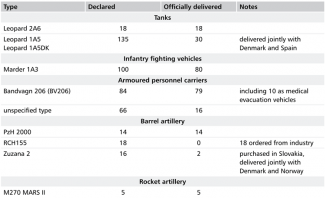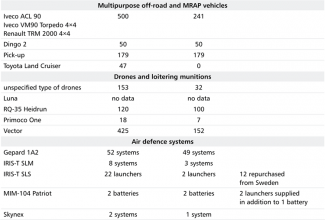Germany boosts its funding for military support to Ukraine
According to the coalition government’s compromise on the 2024 budget (see ‘Germany: the budget crisis has been resolved’), Germany will raise its funding for military aid to Ukraine from the planned €4 billion to €8 billion in the coming year under the programme for military support to partner countries (Ertüchtigungsinitiative der Bundesregierung – EIBReg). Moreover, the German government has not ruled out a further expansion of its assistance in 2024, although that would require it to suspend the so-called debt brake in the federal budget. The government’s new financial plan must still be approved by the Bundestag.
In addition, Olaf Scholz’s cabinet has €10.5 billion in available commitment appropriations for military support to Ukraine (Verpflichtungsermächtigungen); these will be implemented in subsequent financial years.
According to the ministry of defence, the funds allocated to military support for Ukraine between 24 February 2022 and 8 December 2023 totalled €5.66 billion.
Commentary
- According to media reports, Germany’s decision to boost its funding for military assistance to Ukraine was motivated by the fact that it had already allocated almost the entire pool of €4 billion earmarked for 2024 to implement the earlier pledges: only €200 million remained available. However, other factors may have also been at play. The US Congress is yet to vote on an aid package for Ukraine that includes military support for next year. It is unclear when it will be approved and how much funding will be allocated, which means that the additional funds from Germany could prove crucial. As discussions in Congress continue to drag on, Germany’s decisions are helping to cement its image as Ukraine’s only reliable partner in the EU and NATO which has the capacity to provide large sums of money for defence. Calculations from the Kiel Institute for the World Economy also support this image: according to these estimates, from January 2022 to October 2023 the value of Germany’s military support to Ukraine totalled as much as €17.1 billion. This figure includes both the costs of arms and military equipment that have already been delivered and the commitments to be implemented in the coming years, as well as the non-military equipment and materials transferred to all of Ukraine’s security forces: the Armed Forces, the National Guard, the Border Guard and the Police. However, the German defence ministry has reported that the country’s actual value of military aid to Ukraine has totalled €5.66 billion, which does not correspond with Germany’s status as the EU’s largest economy. The German government will include the extra money to support Ukraine in its defence expenditure, which will help Berlin reach the target of spending 2% of the country’s GDP (c. €80 billion) on defence for the first time after the end of the Cold War. Ahead of the NATO summit in Washington in July 2024, this will be a valuable argument for Germany to confirm that it is meeting its obligations as a member of the alliance.
- Funds formally counted as military aid to Ukraine have been used for different purposes. Firstly, they have financed the replenishment of the weapons that have been transferred to Ukraine from the Bundeswehr’s stocks. To date, the German Armed Forces have provided Ukraine with 18 Leopard 2A6 tanks, two Patriot air defence (batteries, 14 PzH 2000 self-propelled howitzers and five MARS II multiple rocket launchers . In order to fill the resulting gaps in the Bundeswehr’s stocks, the German defence ministry has used its funds for military aid to Ukraine to place orders for 18 Leopard 2A8 tanks (€525.6 million), 22 self-propelled howitzers (€470.2 million), 50 Dingo 2 armoured vehicles (€150 million) and ammunition. According to the new budget plan, in 2024 funding for the process to replenish the weapons that have been transferred to Ukraine (worth €520 million) will come from a special fund for the modernisation of the German Armed Forces. Secondly, the funds included in Germany’s military aid to Ukraine have covered the costs of replacing the tanks and infantry fighting vehicles that have been transferred through the Czech Republic, Slovakia, Slovenia and Greece as part of the Ringtausch exchange (see Table 2 in the Appendix). Thirdly, Germany has used these funds to finance the orders that Ukraine has placed with German arms companies, such as those for 18 RCH155 howitzers, and the defence ministry’s purchases of weapons for Ukraine, including 16 Zuzana 2 howitzers that it has ordered jointly with Denmark and Norway from Slovakia. Germany has also included its contribution to the European Peace Facility (EPF), which reimburses the costs of the military equipment that the EU countries transfer to Ukraine, as part of German military aid to Kiev. According to media reports, the German government has demanded that in the future both cash payments and the value of direct deliveries of military equipment should be counted as national contributions to the EPF. Germany, which reportedly accounts for 26% of the EPF’s total funds, would like to deduct the value of the weapons it transfers directly to Ukraine from its contribution; this would significantly reduce its financial commitment to the EPF.
- So far, Germany’s deliveries of arms and military equipment to Ukraine have mainly focused on logistical equipment and air defence systems, protective and non-lethal material, and ammunition (see Table 1 in the Appendix). It has refrained from transferring amounts of ‘offensive’ weapons to Ukraine (see the chapter ‘Germany’s Zeitenwende and the future of the European security architecture’). This is consistent with the strategy of the German Chancellery, which has insisted that it is seeking to avoid an escalation of the conflict by sending primarily ‘defensive’ equipment to Ukraine.
APPENDIX
Table 1. Selected categories of military equipment that Germany has transferred to Ukraine (as of 14 December 2023)


For a comparison with the support that other countries have offered to Ukraine, see the ‘Arms deliveries monitor’.
Table 2. Military equipment transferred as part of the Ringtausch exchange





